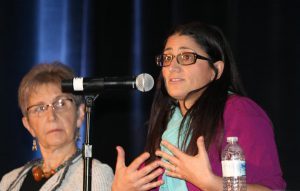You can’t talk about health equity without talking about environmental justice. Speakers at the American Public Health Association’s (APHA) Environmental Justice Town Hall made clear that allies in the fight for safer, healthier communities must look at the environmental factors that contribute to worse health outcomes among marginalized and underserved populations. The town hall was part of the APHA’s annual meeting held this week in San Diego. Here at The Pump Handle, we are sharing some of the great reporting about the event, courtesy of the APHA Annual Meeting blog.
Communities most affected by pollution also disproportionately feel the impact of social determinants such as low levels of education, poor housing and lack of green space, said Diane Takvorian, executive director of the Environmental Health Coalition in San Diego, during the APHA Annual Meeting event. But how do we make sense of the environmental impacts on health and wellness in these communities? Enter CalEnviroScreen, a mapping tool that shows the burden of pollution and population characteristics across California.

Developing the tool was a matter of deep importance for Arsenio Mataka, special assistant to California Attorney General Xavier Becerra. Mataka grew up in the San Joaquin Valley, where kids in his neighborhood played football in the cemetery because they didn’t have access to safe green space. He remembers seeing his parents dismissed at local government meetings when they brought up community environmental concerns.
When Mataka got to the California Environmental Protection Agency, he had to make the case for a pollution screening tool to both the organization and community members. But he knew that it would help empower people with evidence-based information about where they lived.
“We were driven by this belief that if we could somehow quantify the burden of pollution that people were catching hell from that we could change course of communities,” Mataka said. Continue reading….
